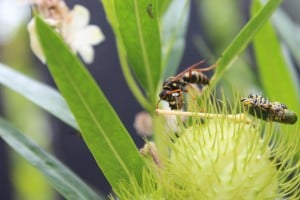Chemical warfare in the garden,
Early summer and dark chemical processes are at work in the bright sunlight. Swan plants are producing and stockpiling deadly molecules in their sap and leaves. A chemical defence system designed to kill insects foraging for food. The main components of this molecular arsenal are cardenolide glycosides, steroids with an attached sugar structure. These toxins can induce cardiac arrest.
Monarch caterpillars and butterflies are immune to these poisons. Caterpillars voraciously devour swan plant leaves. In the process they hijack the plant’s chemical defence system for use against predators. Birds associate becoming sick with a diet of brightly coloured caterpillars or butterflies and drop them from their diet.
Attack of the killer wasps.
Asian paper wasps are very determined predators of monarch caterpillars and are unaffected by the cardenolides. Wasps need protein for nest construction and developing larvae in spring and early summer. Caterpillars are a good source of protein at this stage.
I watched wasps make their way through dense foliage in relentless pursuit of their prey. Monarch caterpillars appear to understand the danger and some seek refuge amongst the spines of the swan plant seed pods. The aerial bombardment is relentless and a plant can be completely stripped of the caterpillar population in a day. The big mature caterpillars are a favourite target and I have seen them stand up on a leaf in a forlorn attempt to beat off a merciless attacker.
The assault has a number of stages
- The wasp lands on the caterpillar and probably stings it
- The wasp starts to skin the caterpillar while it is still moving. It bites through the skin which rolls back to reveal the underlying body.
- It may move the whole carcass to a more stable location where it slices it up into manageable chunks to fly away with.
In late summer when the need for protein has diminished, wasps change their diet, feasting instead on the nectar produced by swan plant flowers.
For more information on cardenolide concentrations and effect on predators.
Relationship beteeen steroids and cardenolide glycosides
Oleandrin is one of the cardenolide glycosicdes found in swan plants. The structure hanging on to the bottom left of the steroid skeleton is based on a sugar unit hence the glycoside in the name.


